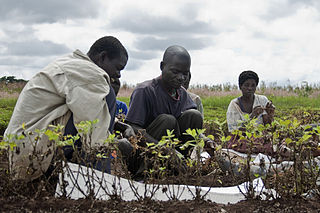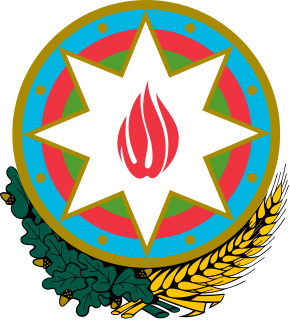Related Research Articles
Agrarianism is a political and social philosophy that has promoted subsistence agriculture, smallholdings, egalitarianism, with agrarian political parties normally supporting the rights and sustainability of small farmers and poor peasants against the wealthy in society. In highly developed and industrial nations or regions it can denote use of financial and social incentives for self-sustainability, more community involvement in food production and smart growth that avoids urban sprawl and, many of its advocates contend, risks of human overpopulation; when overpopulation occurs the available resources become too limited for the entire population to survive comfortably or at all in the long term.

Land reform is a form of agrarian reform involving the changing of laws, regulations, or customs regarding land ownership. Land reform may consist of a government-initiated or government-backed property redistribution, generally of agricultural land. Land reform can, therefore, refer to transfer of ownership from the more powerful to the less powerful, such as from a relatively small number of wealthy or noble owners with extensive land holdings to individual ownership by those who work the land. Such transfers of ownership may be with or without compensation; compensation may vary from token amounts to the full value of the land.
Mission Zamora is an integrated land reform and land redistribution program in Venezuela, created in law by the Ley de Tierras, part of a package of 49 decrees made by Hugo Chávez in November 2001. The plan is named in honor of Ezequiel Zamora, a 19th-century Venezuelan peasant leader.
Trade can be a key factor in economic development. The prudent use of trade can boost a country's development and create absolute gains for the trading partners involved. Trade has been touted as an important tool in the path to development by prominent economists. However trade may not be a panacea for development as important questions surrounding how free trade really is and the harm trade can cause domestic infant industries to come into play.

The main economic products of Malawi are tobacco, tea, cotton, groundnuts, sugar and coffee. These have been among the main cash crops for the last century, but tobacco has become increasingly predominant in the last quarter-century, with a production in 2011 of 175,000 tonnes. Over the last century, tea and groundnuts have increased in relative importance while cotton has decreased. The main food crops are maize, cassava, sweet potatoes, sorghum, bananas, rice, and Irish potatoes and cattle, sheep and goats are raised. The main industries deal with agricultural processing of tobacco, tea and sugar and timber products. The industrial production growth rate is estimated at 10% (2009).

Agriculture is considered the backbone of Pakistan's economy, which relies heavily on its major crops. Pakistan's principal natural resources are arable land and water. Agriculture accounts for about 18.9% of Pakistan's GDP and employs about 42.3% of the labour force. In Pakistan, the most agricultural province is Punjab where wheat and cotton are the most grown. Mango orchards are mostly found in Sindh and Punjab provinces that make Pakistan the world's 4th largest producer of mangoes.
Operation Barga was a land reform movement throughout rural West Bengal for recording the names of sharecroppers (jotadars) while avoiding the time-consuming method of recording through the settlement machinery. It bestowed on the bargadars, the legal protection against eviction by the landlords, and entitled them to the due share of the produce. Operation Barga was launched in 1978 and concluded by the mid-1980s.
Rural poverty refers to poverty in rural areas, including factors of rural society, rural economy, and political systems that give rise to the poverty found there. Rural areas, because of their spread-out populations, typically have less well maintained infrastructure and a harder time accessing markets, which tend to be concentrated in population centers. Rural communities also face disadvantages in terms of legal and social protections, with women and marginalized communities frequently having hard times accessing land, education and other support systems that help with economic development. Several policies have been tested in both developing and developed economies, including rural electrification and access to other technologies such as internet, gender parity, and improved access to credit and income.
The Comprehensive Agrarian Reform Program, more commonly known as CARP, is an agrarian reform law of the Philippines whose legal basis is the Republic Act No. 6657, otherwise known as the Comprehensive Agrarian Reform Law (CARL). It is the redistribution of private and public agricultural lands to help the beneficiaries survive as small independent farmers, regardless of the “tenurial” arrangement. Its goals are to provide landowners equality in terms of income and opportunities, empower land owner beneficiaries to have equitable land ownership, enhance agricultural production and productivity, provide employment to more agricultural workers, and put an end to conflicts regarding land ownership.

Social protection, as defined by the United Nations Research Institute for Social Development, is concerned with preventing, managing, and overcoming situations that adversely affect people's well-being. Social protection consists of policies and programs designed to reduce poverty and vulnerability by promoting efficient labour markets, diminishing people's exposure to risks, and enhancing their capacity to manage economic and social risks, such as unemployment, exclusion, sickness, disability, and old age. It is one of the targets of the United Nations Sustainable Development Goal 10 aimed at promoting greater equality.

The Ministry of Agriculture of Azerbaijan is an Azerbaijani governmental agency within the Cabinet of Azerbaijan in charge of regulation of the economic activity in the agricultural sector of the country with a purpose of increasing the sector's production capacity. Agriculture is Azerbaijan's second most important natural resource playing a significant role in the country's economy. The ministry is headed by Inam Karimov.
Land reform refers to efforts to reform the ownership and regulation of land in India. Or, those lands which are redistributed by the government from landholders to landless people for agriculture or special purpose is known as Land Reform.
In feminist economics, the feminization of agriculture refers to the measurable increase of women's participation in the agricultural sector, particularly in the developing world. The phenomenon started during the 1960s with increasing shares over time. In the 1990s, during liberalization, the phenomenon became more pronounced and negative effects appeared in the rural female population. Afterwards, agricultural markets became gendered institutions, affecting men and women differently. In 2009 World Bank, FAO & IFAD found that over 80 per cent of rural smallholder farmers worldwide were women, this was caused by men migrating to find work in other sectors. Out of all the women in the labor sector, the UN found 45-80% of them to be working in agriculture

Gender inequality both leads to and is a result of food insecurity. According to estimates women and girls make up 60% of the world's chronically hungry and little progress has been made in ensuring the equal right to food for women enshrined in the Convention on the Elimination of All Forms of Discrimination Against Women. Women face discrimination both in education and employment opportunities and within the household, where their bargaining power is lower. On the other hand, gender equality is described as instrumental to ending malnutrition and hunger. Women tend to be responsible for food preparation and childcare within the family and are more likely to be spent their income on food and their children's needs. The gendered aspects of food security are visible along the four pillars of food security: availability, access, utilization and stability, as defined by the Food and Agriculture Organization.
Agrarian reform and land reform have been a recurring theme of enormous consequence in world history. They are often highly political and have been achieved in many countries.
Land reform in the Philippines has long been a contentious issue rooted in the Philippines's Spanish Colonial Period. Some efforts began during the American Colonial Period with renewed efforts during the Commonwealth, following independence, during Martial Law and especially following the People Power Revolution in 1986. The current law, the Comprehensive Agrarian Reform Program, was passed following the revolution and recently extended until 2014.
The Agricultural Development and Marketing Corporation, usually known as ADMARC, was formed in Malawi in 1971 as a Government-owned corporation or parastatal to promote the Malawian economy by increasing the volume and quality of its agricultural exports, to develop new foreign markets for the consumption of Malawian agricultural produce and to support Malawi's farmers. it was the successor of a number of separate marketing boards of the colonial-era and early post-colonial times, whose functions were as much about controlling African smallholders or generating government revenues as in promoting agricultural development. At its foundation, ADMARC was given the power to finance the economic development of any public or private organisation, agricultural or not.
Land reform in South Africa is the promise of "land restitution" to empower farm workers and reduce inequality. This also refers to aspects such as, property, possibly white owned businesses. It is believed to allow previously unemployed people to participate in the economy and better the country's economic growth. It also relates to restitution in the form of settling Land Claims of people who were forcefully removed from their homes in urban areas that were declared white, by the apartheid government's segregationist Group Areas Act: such areas include Sophiatown, Fietas, Cato Manor, District Six and Greyville; as well as restitution for people forcibly evicted from rural land because of apartheid policies.
Villagization was a land reform and resettlement program in Ethiopia implemented by the Derg in 1985 that aimed to systematize and regulate village life and rural agriculture. Villagization typically involved the relocation of rural communities or nomadic groups to planned villages with communal farmland.
Concentration of land ownership refers to the ownership of land in a particular area by a small number of people or organizations. It is sometimes defined as additional concentration beyond that which produces optimally efficient land use.
References
- ↑ Csaba Csaki and John Nash, The Agrarian Economies of Central and Eastern Europe and the Commonwealth of Independent States, World Bank Discussion Paper 387, Washington, DC, 1998. https://elibrary.worldbank.org/doi/abs/10.1596/0-8213-4238-X#
- ↑ "Agrarian reform". UNBIS Thesaurus. Retrieved 21 June 2020.
- ↑ Ben Cousins, Agrarian reform and the 'two economies': transforming South Africa's countryside, draft of Chapter 9 in Ruth Hall and Lungisile Ntsebeza, eds., The Land Question in South Africa: The Challenge of Transformation and Redistribution, HSRC Press, Cape Town, South Africa (2007).
- ↑ World Bank, Land Policies for Growth and Poverty Reduction, World Bank and Oxford University Press, 2003. Quoted in Cousins, op. cit., p. 11.
- ↑ Cousins, op. cit., p.4–5, 7, 10–11
- ↑ Cousins, op. cit., p.12
- 1 2 Cousins, op. cit., p.14